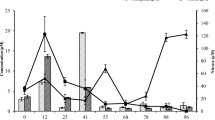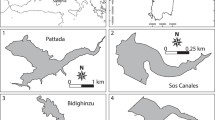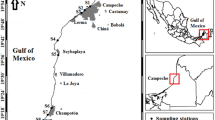Abstract
Species of the diatom genus Pseudo-nitzschia, some of which produce the neurotoxin domoic acid (DA), were studied to see how environmental factors affect their distribution in two tropical monsoonal estuaries and how salinity influences the growth and toxicity of P. pungens. Pseudo-nitzschia pungens, P. multistriata, and P. seriata were present in both the Mandovi and Zuari estuaries, whereas P. australis and P. pseudodelicatissima appeared only in the Zuari estuary. Canonical correspondence analysis indicated a significant positive correlation between salinity and the occurrence of P. seriata in the Mandovi estuary and of P. pungens in the Zuari estuary. A strain of P. pungens isolated from the Zuari estuary showed significant variations in specific growth rate between salinities, in support of our finding of a relationship between salinity and its distribution in the field. The lowest growth rate (0.44 day−1) was at a salinity of 5 and it increased to a maximum (1.05–1.19 day−1) at salinities of 15 to 30, declining slightly (0.98 day−1) at a salinity of 35. The isolated strain produced DA but at low levels. DA production rates varied significantly with salinity; they were low and similar at salinities of 5–15 (2.56–3.12 ng ml−1 day−1) and increased with increasing salinity, reaching 5.25 ng ml−1 day−1 at 35. The observed variations in growth rate and DA production by P. pungens indicate the need to focus more on salinity as an environmental factor that affects this, and other Pseudo-nitzschia species, in these monsoonal waters.







Similar content being viewed by others
References
Almandoz, G.O., M.E. Ferrario, G.A. Ferreyra, I.R. Schloss, J.L. Esteves, and F.E. Paparazzo. 2007. The genus Pseudo-nitzschia (Bacillariophyceae) in continental shelf waters of Argentina (Southwestern Atlantic Ocean, 38–55°S). Harmful Algae 6 (1): 93–103. https://doi.org/10.1016/j.hal.2006.07.003.
Anderson, D.M., P.M. Gilbert, and J.M. Burkholder. 2002. Harmful algal blooms and eutrophication: nutrient sources, composition and consequences. Estuaries 25 (4): 704–726. https://doi.org/10.1007/BF02804901.
Anderson, C.R., M.R.P. Sapiano, M.B.K. Prasad, W. Long, P.J. Tango, C.W. Brown, and R. Murtugudde. 2010. Predicting potentially toxigenic Pseudo-nitzschia blooms in the Chesapeake Bay. Journal of Marine Systems 83 (3-4): 127–140. https://doi.org/10.1016/j.jmarsys.2010.04.003.
Bargu, S., M.M. Baustian, N.N. Rabalais, R. Del Rio, B. Von Korff, and R.E. Turner. 2016. Influence of the Mississippi River on Pseudo-nitzschia spp. abundance and toxicity in Louisiana coastal waters. Estuaries and Coasts 39 (5): 1345–1356. https://doi.org/10.1007/s12237-016-0088-y.
Bates, S.S. 1998. Physiological ecology of harmful algal blooms. In Physiological ecology of harmful algal blooms, ed. D.M. Anderson, A.D. Cembella, and G.M. Hallegraeff, 405–426. Heidelberg: Springer-Verlag.
Bates, S.S., and V.L. Trainer. 2006. The ecology of harmful diatoms. In Ecology of harmful algae, Ecological Studies, ed. E. Granéli and J.T. Turner, vol. 189, 81–93. Heidelberg: Springer.
Bates, S.S., D.L. Garrison, and R.A. Horner. 1998. Bloom dynamics and physiology of domoic-acid-producing Pseudo-nitzschia species. In Physiological ecology of harmful algal blooms, ed. D.M. Anderson, A.D. Cembella, and G.M. Hallegraeff, 267–292. Heidelberg: Springer-Verlag.
Baugh, K.A., J.M. Bush, B.D. Bill, K.A. Lefebvre, and V.L. Trainer. 2006. Estimates of specific toxicity in several Pseudo-nitzschia species from the Washington coast, based on culture and field studies. African Journal Marine Science 28: 393–397.
Brand, L. 1984. The salinity tolerance of forty-six marine phytoplankton isolates. Estuarine, Coastal and Shelf Science 18 (5): 543–556. https://doi.org/10.1016/0272-7714(84)90089-1.
Calu, G., V. Martin-Jézéquel, E. Lefau, V. Séchet, P. Lassus, P. Weigel, and Z. Amzil. 2009. The influence of nitrogen speciation on growth and toxicity of Pseudo-nitzschia multiseries and P. pungens in batch and continuous cultures. In 7th International Conference on Molluscan Shellfish Safety, ed. P. Lassus, 7 p. Nantes, France: Editions Quæ.
Casteleyn, G., V.A. Chepurnov, F. Leliaert, D.G. Mann, S.S. Bates, N. Lundholm, L. Rhodes, K. Sabbe, and W. Vyverman. 2008. Pseudo-nitzschia pungens (Bacillariophyceae): a cosmopolitan diatom species? Harmful Algae 7 (2): 241–257. https://doi.org/10.1016/j.hal.2007.08.004.
Couture, J. Y., M. Levasseur, E. Bonneau, C. Desjardins, G. Sauvé, S. S. Bates, C. Léger, R. Gagnon, and S. Michaud. 2001. Spatial and temporal variation of domoic acid in molluscs and of Pseudo-nitzschia spp. blooms in the St. Lawrence from 1998 to 2000. Canadian Technical Report of Fisheries and Aquatic Sciences 2375: vii + 24 p.
Dao, H.V., V.B. Phan, S.T. Teng, H. Uchida, C.P. Leaw, P.T. Lim, T. Suzuki, and K.X. Pham. 2015. Pseudo-nitzschia fukuyoi (Bacillariophyceae), a domoic acid-producing species from Nha Phu Bay, Khanh Hoa Province, Vietnam. Fisheries Science 81 (3): 533–539. https://doi.org/10.1007/s12562-015-0864-9.
De Sousa, S.N. 1983. Studies on the behaviour of nutrients in the Mandovi estuary during premonsoon. Estuarine, Coastal and Shelf Science 16 (3): 299–308. https://doi.org/10.1016/0272-7714(83)90147-6.
Devassy, V.P., and J.I. Goes. 1988. Phytoplankton community structure and succession in tropical estuarine complex. Estuarine, Coastal and Shelf Science 27 (6): 671–685. https://doi.org/10.1016/0272-7714(88)90074-1.
Doucette, G.J., K.L. King, A.E. Thessen, and Q. Dortch. 2008. The effect of salinity on domoic acid production by the diatom Pseudo-nitzschia multiseries. Nova Hedwigia. Beiheft 133: 31–46.
Du, X., W. Peterson, J. Fisher, M. Hunter, and J. Peterson. 2016. Initiation and development of a toxic and persistent Pseudo-nitzschia bloom off the Oregon coast in spring/summer 2015. PLoS One 11 (10): e0163977. https://doi.org/10.1371/journal.pone.0163977.
Fehling, J., D.H. Green, K. Davidson, C.J. Bolch, and S.S. Bates. 2004. Domoic acid production by Pseudo-nitzschia seriata (Bacillariophyceae) in Scottish waters. Journal of Phycology 40 (4): 622–630. https://doi.org/10.1111/j.1529-8817.2004.03200.x.
Fehling, J., K. Davidson, C. Bolch, and P. Tett. 2006. Seasonality of Pseudo-nitzschia spp. (Bacillariophyceae) in western Scottish waters. Marine Ecology Progress Series 323: 91–105. https://doi.org/10.3354/meps323091.
Fernandes, L.F., K.A. Hubbard, M. Richlen, J. Smith, S.S. Bates, J. Ehrman, C. Léger, L.L. Mafra Jr., D. Kulis, M. Quilliam, D. Erdner, K. Libera, L. McCauley, and D. Anderson. 2014. Diversity and toxicity of the diatom Pseudo-nitzschia Peragallo in the Gulf of Maine, Northwestern Atlantic Ocean. Deep Sea Research, Part II 103: 139–162. https://doi.org/10.1016/j.dsr2.2013.06.022.
Guillard, R.R.L. 1975. Culture of phytoplankton for feeding marine invertebrates. In Culture of marine invertebrate animals, ed. W.L. Smith and M.H. Chanley, 181–194. New York: Plenum Press. https://doi.org/10.1007/978-1-4615-8714-9_3.
Hasle, G.R. 2002. Are most of the domoic acid-producing species of the diatom genus Pseudo-nitzschia cosmopolites? Harmful Algae 1 (2): 137–146. https://doi.org/10.1016/S1568-9883(02)00014-8.
Hasle, G.R., and E.E. Syvertsen. 1997. Marine diatoms. In Identifying marine phytoplankton, ed. C.R. Thomas, 5–386. San Diego: Academic Press. https://doi.org/10.1016/B978-012693018-4/50004-5.
Horner, R.A., B.M. Hickey, and J.R. Postel. 2000. Pseudo-nitzschia blooms and physical oceanography off Washington State, USA. South African Journal of Marine Science 22 (1): 299–308. https://doi.org/10.2989/025776100784125771.
Jackson, A.E., S.W. Ayre, and M.V. Laycock. 1992. The effect of salinity on growth and amino acid composition in the marine diatom Nitzschia pungens. Canadian Journal of Botany 70 (11): 2198–2201. https://doi.org/10.1139/b92-272.
Kaczmarska, I., M.M. LeGresley, J.L. Martin, and J. Ehrman. 2005. Diversity of the diatom genus Pseudo-nitzschia Peragallo in the Quoddy region of the Bay of Fundy, Canada. Harmful Algae 4 (1): 1–19. https://doi.org/10.1016/j.hal.2003.07.001.
Kim, J.H., B.S. Park, J.H. Kim, P. Wang, and M.S. Han. 2015. Intraspecific diversity and distribution of the cosmopolitan species Pseudo-nitzschia pungens (Bacillariophyceae): morphology, genetics, and ecophysiology of the three clades. Journal of Phycology 51: 159−172.
Kovach, W. 1998. MultiVariate Statistical Package. Release 3.13p. Pentraeth, Kovach Computing Services, Anglesey, Wales. http://www.kovcomp.co.uk/mvsp/
Krishna, Kumari L., P.M.A. Bhattathiri, S.G.P. Matondkar, and J. John. 2002. Primary productivity in Mandovi-Zuari estuaries in Goa. Journal of the Marine Biological Association of India 44: 1–13.
Lelong, A., H. Hégaret, P. Soudant, and S.S. Bates. 2012. Pseudo-nitzschia (Bacillariophyceae) species, domoic acid and amnesic shellfish poisoning: revisiting previous paradigms. Phycologia 51 (2): 168–216. https://doi.org/10.2216/11-37.1.
Liefer, J.D., H.L. MacIntyre, L. Novoveská, W.L. Smith, and C.P. Dorsey. 2009. Temporal and spatial variability in Pseudo-nitzschia spp. in Alabama coastal waters: a “hot spot” linked to submarine groundwater discharge? Harmful Algae 8 (5): 706–714. https://doi.org/10.1016/j.hal.2009.02.003.
Lim, H.C., P.T. Lim, S.T. Teng, S.S. Bates, and C.P. Leaw. 2014a. Genetic structure of Pseudo-nitzschia pungens (Bacillariophyceae) populations: implications of a global diversification of the diatom. Harmful Algae 37: 142–152. https://doi.org/10.1016/j.hal.2014.06.004.
Lim, H.C., S.T. Teng, C.P. Leaw, S.-Z. binti Kamarudin, and P.T. Lim. 2014b. Growth response of Pseudo-nitzschia circumpora (Bacillariophyceae) to different salinities. In Harmful algae 2012, ed. H.G. Kim, B. Reguera, G.M. Hallegraeff, C.K. Lee, M.S. Han, and J.K. Choi, 135–136. Paris: International Society for the Study of Harmful Algae, Intergovernmental Oceanographic Commission of UNESCO.
Lim, H.C., S.T. Teng, C.P. Leaw, S.Z. Binti Kamarudin, and P.T. Lim. 2015. Growth response of Pseudonitzschia circumpora (Bacillariophyceae) to different salinities. In: H.G. Kim (Ed.). Proceedings of the 15th International Conference on Harmful Algae. Intergovernmental Oceanographic Commission of UNESCO, Paris.
Lundholm, N. (Ed.) 2017. Bacillariophyceae. In IOC-UNESCO taxonomic reference list of harmful micro algae. http://www.marinespecies.org/hab.
MacIntyre, H.L., A.L. Stutes, W.L. Smith, C.P. Dorsey, A. Abraham, and R.W. Dickey. 2011. Environmental correlates of community composition and toxicity during a bloom of Pseudo-nitzschia spp. in the northern Gulf of Mexico. Journal of Plankton Research 33 (2): 273–295. https://doi.org/10.1093/plankt/fbq146.
Maldonado, M.T., M.P. Hughes, E.L. Rue, and M.L. Wells. 2002. The effect of Fe and Cu on growth and domoic acid production by Pseudo-nitzschia multiseries and Pseudo-nitzschia australis. Limnology and Oceanography 47 (2): 515–526. https://doi.org/10.4319/lo.2002.47.2.0515.
Markina, Z.V., and N.A. Aizdaicher. 2016. The effect of lowered salinity of sea water on the growth and photosynthetic pigment content in three strains of the microalgae Pseudo-nitzschia pungens (Grunow ex. P.T. Cleve) Hasle, 1993 (Bacillariophyta). Russian Journal of Marine Biology 42 (5): 414–418. https://doi.org/10.1134/S1063074016050060.
Martin, G.D., J.G. Vijay, C.M. Laluraj, N.V. Madhu, T. Joseph, M. Nair, G.V.M. Gupta, and K.K. Balachandran. 2008. Fresh water influence on nutrient stoichiometry in a tropical estuary, southwest coast of India. Applied Ecology and Environmental Research 6: 57–64.
Maya, M.V., M.A. Soares, R. Agnihotri, A.K. Pratihary, S. Karapurkar, H. Naik, and S.W.A. Naqvi. 2011. Variations in some environmental characteristics including C and N stable isotopic composition of suspended organic matter in the Mandovi estuary. Environmental Monitoring and Assessment 175 (1-4): 501–517. https://doi.org/10.1007/s10661-010-1547-8.
Miller, P.E., and C.A. Scholin. 1998. Identification and enumeration of cultured and wild Pseudo-nitzschia (Bacillariophyceae) using species-specific LSU rRNA-targeted fluorescent probes and filter-based whole cell hybridization. Journal of Phycology 34 (2): 371–382. https://doi.org/10.1046/j.1529-8817.1998.340371.x.
Mochemadkar, S., M. Gauns, A. Pratihary, B. Thorat, R. Roy, I.K. Pai, and S.W.A. Naqvi. 2013. Response of phytoplankton to nutrient enrichment with high growth rates in a tropical monsoonal estuary—Zuari estuary, India. Indian Journal of Geo-Marine Sciences 42: 314–325.
Pan, Y., D.V. Subba Rao, K.H. Mann, R.G. Brown, and R. Pocklington. 1996. Effects of silicate limitation on production of domoic acid, a neurotoxin, by the diatom Pseudo-nitzschia multiseries (Hasle). I. Batch culture studies. Marine Ecological Progress Series 131: 225–233.
Pan, Y., S.S. Bates, and A.D. Cembella. 1998. Environmental stress and domoic acid production by Pseudo-nitzschia: a physiological perspective. Natural Toxins 6 (3-4): 127–135. https://doi.org/10.1002/(SICI)1522-7189(199805/08)6:3/4<127::AID-NT9>3.0.CO;2-2.
Parab, S.G., S.G.P. Matondkar, H. Gomes, and J.I. Goes. 2006. Monsoon driven changes in phytoplankton populations in the eastern Arabian Sea as revealed by microscopy and HPLC pigment analysis. Continental Shelf Research 26 (20): 2538–2558. https://doi.org/10.1016/j.csr.2006.08.004.
Patil, J.S., and A.C. Anil. 2008. Temporal variation of diatom benthic propagules in a monsoon-influenced tropical estuary. Continental Shelf Research 28 (17): 2404–2416. https://doi.org/10.1016/j.csr.2008.06.001.
Pednekar, S.M., S.G. Matondkar Prabhu, and V. Kerkar. 2012. Spatiotemporal distribution of harmful algal flora in the tropical estuarine complex of Goa, India. Scientific World Journal 2012: 1–11. https://doi.org/10.1100/2012/596276.
Pocklington, R., J.E. Milley, S.S. Bates, C.J. Bird, A.S.W. de Freitas, and M.A. Quilliam. 1990. Trace determination of domoic acid in seawater and phytoplankton by high-performance liquid chromatography of the fluorenylmethoxycarbonyl (FMOC) derivative. International Journal of Environmental Analytical Chemistry 38 (3): 351–368. https://doi.org/10.1080/03067319008026940.
Quijano-Scheggia, S., E. Garcés, E. Flo, M. Fernandez-Tejedor, J. Diogène, and J. Camp. 2008. Bloom dynamics of the genus Pseudo-nitzschia (Bacillariophyceae) in two coastal bays (NW Mediterranean Sea). Scientia Marina 72: 577–590.
Rhodes, L.L., D. White, M. Syhre, and M. Atkinson. 1996. Pseudo-nitzschia species isolated from New Zealand coastal waters: domoic acid production in vitro and links with shellfish toxicity. In Harmful and toxic algal blooms, ed. T. Yasumoto, Y. Oshima, and Y. Fukuyo, 155–158. Paris: Intergovernmental Oceanographic Commission of UNESCO.
Schnetzer, A., B.H. Jones, R.A. Schaffner, I. Cetinic, E. Fitzpatrick, P.E. Miller, E.L. Seubert, and D.A. Caron. 2013. Coastal upwelling linked to toxic Pseudo-nitzschia australis blooms in Los Angeles coastal waters, 2005–2007. Journal of Plankton Research 35 (5): 1080–1092. https://doi.org/10.1093/plankt/fbt051.
Shetye, S. R., A. D. Gouveia, S. Y. S. Singbal, C. G. Naik, D. Sundar, G. S. Michael, and G. Nampoothiri. 1999. Propagation of tides in the Mandovi-Zuari estuarine network. Proceedings of the Workshop on Integrated Coastal Land Marine Area Management Plan for Goa Department of Science Technology and Environment. Govt. of Goa, Saligao, Bardez, Goa. ICMAM-PD, Chennai, India, pp 174–193.
Shetye, S.R., D. Shankar, S. Neetu, K. Suprit, G.S. Michael, and P. Chandramohan. 2007. The environment that conditions the Mandovi and Zuari estuaries. In The Mandovi and Zuari estuaries, ed. S.R. Shetye, M.D. Kumar, and D. Shankar, 3–27. Dona Paula: National Institute of Oceanography.
Stewart, J.E., L.J. Marks, C.R. Wood, S.M. Risser, and S. Gray. 1997. Symbiotic relations between bacteria and the domoic acid producing diatom Pseudo-nitzschia multiseries and the capacity of these bacteria for gluconic acid/gluconolactone formation. Aquatic Microbial Ecology 12: 211–221. https://doi.org/10.3354/ame012211.
Strickland, J.D.H., and T.R. Parsons. 1972. A practical handbook of seawater analysis. 2nd ed. Ottawa: Fisheries Research Board of Canada.
Subha Anand, S., S. Sardessai, C. Muthukumar, K.R. Mangalaa, D. Sundar, S.G. Parab, and M. Dileep Kumar. 2014. Intra- and inter-seasonal variability of nutrients in a tropical monsoonal estuary (Zuari, India). Continental Shelf Research 82: 9–30. https://doi.org/10.1016/j.csr.2014.04.005.
Teng, S.T., S.N. Tan, H.C. Lim, V.H. Dao, S.S. Bates, and C.P. Leaw. 2016. High diversity of Pseudo-nitzschia along the northern coast of Sarawak (Malaysian Borneo), with descriptions of P. bipertita sp. nov. and P. limii (Bacillariophyceae). Journal of Phycology 52 (6): 973–989. https://doi.org/10.1111/jpy.12448.
ter Braak, C.J.F. 1995. Ordination. In Data analysis in community and landscape ecology, ed. R.H.G. Jongman, C.J.F. ter Braak, and O.F.R. van Tongeren, 91–173. Cambridge: Cambridge University Press. https://doi.org/10.1017/CBO9780511525575.007.
Thessen, A.E., and D.K. Stoecker. 2008. Distribution, abundance and domoic acid analysis of the toxic diatom genus Pseudo-nitzschia from the Chesapeake Bay. Estuaries and Coasts 31 (4): 664–672. https://doi.org/10.1007/s12237-008-9053-8.
Thessen, A.E., Q. Dortch, M.L. Parsons, and W. Morrison. 2005. Effect of salinity on Pseudo-nitzschia species (Bacillariophyceae) growth and distribution. Journal of Phycology 41 (1): 21–29. https://doi.org/10.1111/j.1529-8817.2005.04077.x.
Trainer, V.L., J.C. Wekell, R.A. Horner, C.L. Hatfield, and J.E. Stein. 1998. Domoic acid production by Pseudo-nitzschia pungens. In Harmful algae, ed. B. Reguera, J. Blanco, M.L. Fernández, and Wyatt T. T., 337–340. Paris: Xunta de Galicia and Intergovernmental Oceanographic Commission of UNESCO.
Trainer, V.L., B.M. Hickey, and R.A. Horner. 2002. Biological and physical dynamics of domoic acid production off the Washington coast. Limnology and Oceanography 47 (5): 1438–1446. https://doi.org/10.4319/lo.2002.47.5.1438.
Trainer, V.L., S.S. Bates, N. Lundholm, A.E. Thessen, W.P. Cochlan, N.G. Adams, and C.G. Trick. 2012. Pseudo-nitzschia physiological ecology, phylogeny, toxicity, monitoring and impacts on ecosystem health. Harmful Algae 14: 271–300. https://doi.org/10.1016/j.hal.2011.10.025.
Turner, R.E. 2006. Will lowering estuarine salinity increase Gulf of Mexico oyster landings? Estuaries and Coasts 29 (3): 345–352. https://doi.org/10.1007/BF02784984.
Unnikrishnan, A.S., S.R. Shetye, and A.D. Gouveia. 1997. Tidal propagation in the Mandovi-Zuari estuarine network, west coast of India: impact of freshwater influx. Estuarine, Coastal and Shelf Science 45 (6): 737–744. https://doi.org/10.1006/ecss.1997.0234.
Verlencar, X.N. 1987. Distribution of nutrients in the coastal and estuarine waters of Goa. Mahasagar-Bulletin of the National Institute of. Oceanography 20: 205–215.
Villac, M.C., M.G. Matos, V.S. Santos, A.W. Rodrigues, and S.C. Viana. 2004. Composition and distribution of Pseudo-nitzschia from Guanabara Bay, Brazil: the role of salinity, based on field and culture observations. In Harmful algae 2002, ed. K.A. Steidinger, J.L. Landsberg, and C.R. Tomas, 56–58. Paris: Florida Fish and Wildlife Conservation Commission. Florida Institute of Oceanography, and Intergovernmental Oceanographic Commission of UNESCO.
Wright, S.W., S.W. Jeffrey, R.G.C. Mantoura, C.A. Llewellyn, T. Bjørnland, D. Repeta, and N. Welschmeyer. 1991. Improved HPLC method for the analysis of chlorophylls and carotenoids from marine phytoplankton. Marine Ecology Progress Series 77: 183–196. https://doi.org/10.3354/meps077183.
Acknowledgements
We are grateful to Dr. S.W.A. Naqvi (Director, National Institute of Oceanography) for his support and encouragement. We also thank Dr. Lisette D’Souza (Bioorganic Laboratory, NIO) for the use the HPLC and Dr. Supriya Tilvi (Bioorganic Laboratory, NIO) for assistance with data analysis. The first author acknowledges the Senior Research Fellowship provided by the Council of Scientific and Industrial Research (India). We thank Claude Léger (Fisheries and Oceans Canada, Gulf Fisheries Centre) for providing advice for the domoic acid analyses.
Author information
Authors and Affiliations
Corresponding author
Additional information
Communicated by James L. Pinckney
Electronic supplementary material
ESM 1
(DOC 366 kb)
Rights and permissions
About this article
Cite this article
Pednekar, S.M., Bates, S.S., Kerkar, V. et al. Environmental Factors Affecting the Distribution of Pseudo-nitzschia in Two Monsoonal Estuaries of Western India and Effects of Salinity on Growth and Domoic Acid Production by P. pungens. Estuaries and Coasts 41, 1448–1462 (2018). https://doi.org/10.1007/s12237-018-0366-y
Received:
Revised:
Accepted:
Published:
Issue Date:
DOI: https://doi.org/10.1007/s12237-018-0366-y




